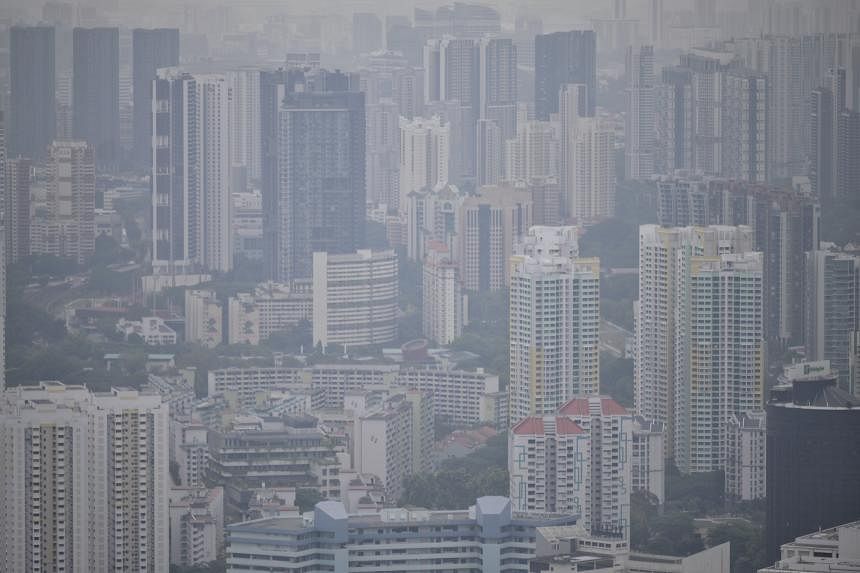SINGAPORE - With the ongoing dry season here expected to be the hottest and driest since 2019, Singapore is bracing itself for the arrival of the haze – from stockpiling of N95 masks to ensuring hospitals are prepared to handle any potential surge in admissions.
Minister for Sustainability and the Environment Grace Fu told Parliament on Wednesday that the authorities are also considering opening up residents’ committee centres and air-conditioned study rooms in community clubs to vulnerable groups such as seniors. This will allow them to seek refuge if the haze hits the island.
She was responding to Mr Yip Hon Weng’s (Yio Chu Kang) suggestion of having “haze sanctuaries” for seniors living in flats without air-conditioners and air purifiers.
The El Nino weather phenomenon, which brings hotter and drier conditions to South-east Asia, is expected to set in over the next one to two months, according to the Singapore-based Asean Specialised Meteorological Centre.
The last El Nino occurred in 2019.
The centre has also forecast that another phenomenon called the positive Indian Ocean Dipole, which causes warmer sea surface temperatures in the western Indian Ocean, is likely to develop between July and August.
“Both climate phenomena will bring drier and warmer weather that could intensify the dry season in Singapore and the region, leading to potentially more hot spots and an increased risk of transboundary haze,” said Ms Fu.
In June, the Singapore Institute of International Affairs said there is a high risk of severe haze occurring in the region in 2023.
The Ministry of Health (MOH) maintains a stockpile of N95 masks and is prepared to release them to retail pharmacies should there be a shortage, said Ms Fu, adding that the ministry has worked with pharmacies to ensure sufficient stocks of the masks.
The inter-agency haze task force also plans to work with the People’s Association to distribute masks to low-income and vulnerable residents in the event of a severe haze episode, she said.
Ms Fu was responding to questions from Mr Yip and Mr Liang Eng Hwa (Bukit Panjang) about ongoing plans to prepare for transboundary haze.
MOH has advised all public healthcare institutions on measures to take to manage a potential increase in hospital admissions due to haze-related illnesses. Doctors have also been advised on how to treat patients with conditions such as asthma and lung diseases.
All school classrooms, including kindergartens under the Ministry of Education and special education schools, are equipped with air purifiers. Nursing homes need to ensure they have sufficient air-purifying equipment and medical supplies, said Ms Fu.
The public should have air purifiers in good working condition and wear N95 masks when engaging in prolonged outdoor activities in the haze, she added.
Residents should refer to the hourly PM2.5 readings before deciding on immediate outdoor activities, and the 24-hour PSI (Pollutant Standards Index) forecast to plan activities for the next day.
The National Environment Agency has a guide on portable air filters for households and it can be referred to here.
Ms Fu said she recently met ministers and officials from the southern Asean region, including Brunei, Indonesia, Malaysia and Thailand, to discuss the haze issue. The countries hope to come to a conclusion leading to the launch of the Asean Coordinating Centre for Transboundary Haze Pollution Control later this year.
She was responding to Mr Liang’s follow-up question on haze-related discussions with the Asean region.
Ms Fu noted that the Indonesian government has over the years made significant efforts in the areas of monitoring, regulations and boosting firefighting capabilities.
“Of course, we were helped by good weather over the last few years but, this year, I think there is common affirmation of the need to monitor the dry season carefully and also act quickly to fight fires,” she said.
Singapore’s air quality was within the good or moderate range for 99.5 per cent of the days in 2021 and for all days in 2022, said Ms Fu, in response to Workers’ Party MP He Ting Ru’s (Sengkang GRC) question on Singapore’s air quality and future targets.
Singapore has met its 2020 air quality targets for nitrogen dioxide, carbon monoxide, sulphur dioxide and PM2.5, or fine particulate matter that can penetrate deeply into the lungs. PM2.5 is the dominant pollutant during episodes of haze.
However, the concentrations of bigger particulate matter PM10 and ozone continue to be higher than desired due to multiple factors, such as the weather and complex chemical reactions between the pollutants and the environment, Ms Fu said.
“We will continue to review our air quality targets as well as policies to address local pollutant emissions. For example, the emission standards for motorcycles and existing industrial plants were further tightened this year.”


